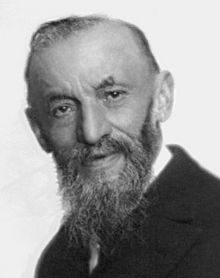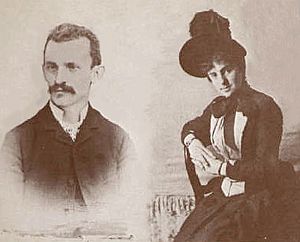Giuseppe Peano facts for kids
Quick facts for kids
Giuseppe Peano
|
|
|---|---|
 |
|
| Born | 27 August 1858 |
| Died | 20 April 1932 (aged 73) |
| Citizenship | Italian |
| Alma mater | University of Turin |
| Known for | Peano axioms Peano curve Peano existence theorem Peano-Jordan measure Peano kernel theorem Peano–Russell notation Latino sine flexione Vector space Peano surface Logicism |
| Awards | Knight of the Order of Saints Maurizio and Lazzaro Knight of the Crown of Italy Commendatore of the Crown of Italy Correspondent of the Accademia dei Lincei |
| Scientific career | |
| Fields | Mathematics Linguistics |
| Institutions | University of Turin, Accademia dei Lincei |
| Doctoral advisor | Enrico D'Ovidio |
| Other academic advisors | Francesco Faà di Bruno |
| Notable students | Maria Gramegna |
| Influences | Euclid, Angelo Genocchi, Gottlob Frege |
| Influenced | Bertrand Russell, Giovanni Vailati |
Giuseppe Peano (27 August 1858 – 20 April 1932) was an Italian mathematician and glottologist (someone who studies languages). He wrote over 200 books and papers. He helped create mathematical logic and set theory, and he invented many math symbols we still use today. The rules for natural numbers, called the Peano axioms, are named after him. He also helped develop mathematical induction, a way to prove things in math. Peano taught mathematics at the University of Turin for most of his life.
He also created a simple international language called Latino sine flexione. This means "Latin without inflections." It was a simplified version of Classical Latin. Most of his books and papers are in this language or in Italian.
Contents
Giuseppe Peano's Early Life and Education
Giuseppe Peano was born and grew up on a farm. This farm was in Spinetta, a small village near Cuneo, Piedmont, Italy. He went to the Liceo classico Cavour in Turin. In 1876, he started studying at the University of Turin. He graduated in 1880 with very high marks.
After graduating, the university hired him to help teach. He first assisted Enrico D'Ovidio. Then he helped Angelo Genocchi, who was the professor of calculus. Professor Genocchi was often unwell. Because of this, Peano took over teaching the calculus course within two years.
Peano's First Major Works and Symbols
In 1884, Peano published his first important work. It was a textbook about calculus. The book was officially credited to Professor Genocchi. A few years later, Peano published his first book about mathematical logic. In this book, he introduced modern symbols. These symbols are used for the union and intersection of sets. These symbols are still used in math today.
In 1887, Peano married Carola Crosio. She was the daughter of Luigi Crosio, a painter from Turin. In 1886, Peano also started teaching at the Royal Military Academy. He became a Professor First Class there in 1889.
Key Mathematical Discoveries
In 1889, Peano published the Peano axioms. These are a set of rules that form the basis for natural numbers. The next year, the University of Turin made him a full professor.
In 1890, he published the Peano curve. This was the first example of a space-filling curve. It showed that a line segment and a square can have the same "number of points." Today, we understand this as an early example of a fractal. Fractals are complex shapes that look similar at different scales.
The Rivista di Matematica and Formulario Project
In 1890, Peano started a math journal called Rivista di Matematica. Its first issue came out in January 1891. In 1891, Peano began the Formulario Project. This project was meant to be an "Encyclopedia of Mathematics." It would contain all known math formulas and theorems. These would be written using a standard notation that Peano invented.
In 1897, the first International Congress of Mathematicians was held in Zürich. Peano was a very important participant. He gave a presentation on mathematical logic. He also started spending more and more time on the Formulario project. This took time away from his other work.
In 1898, he wrote a paper about the binary number system. He showed how it could be used to represent the sounds of languages. He also bought his own printing press. This was because he was frustrated with delays in publishing. He wanted formulas to be printed on a single line.
Peano's Influence and International Recognition
The Second International Congress of Mathematicians took place in Paris in 1900. Before this, the First International Conference of Philosophy was held. Peano was part of the planning committee for this conference. He gave a paper that asked an important question: "How do you define a definition?" This became a main interest for Peano for the rest of his life.
At the conference, Peano met Bertrand Russell, a famous philosopher and mathematician. Peano gave Russell a copy of his Formulario. Russell was very impressed by Peano's new logical symbols. After the conference, Russell went home to study everything Peano had written.
Peano's students, Mario Pieri and Alessandro Padoa, also presented papers at the philosophy conference. Peano did not speak at the math congress. However, Padoa's presentation was very memorable. A proposal was made to create an "international auxiliary language." This language would help mathematicians and business people share ideas more easily. Peano fully supported this idea.
Later Career and the Latino sine flexione Language
By 1901, Peano was at the peak of his math career. He had made progress in analysis, foundations of math, and logic. He also contributed to teaching calculus, differential equations, and vector analysis. Peano was key in setting up the rules (axioms) for mathematics. He was also a leader in developing mathematical logic.
At this point, Peano became very focused on the Formulario project. His teaching started to suffer. He was so determined to teach his new math symbols that he neglected the calculus part of his course. Because of this, he was dismissed from the Royal Military Academy. However, he kept his job at Turin University.
In 1903, Peano announced his work on an international auxiliary language. He called it Latino sine flexione ("Latin without inflexion"). This was a very important project for him. The idea was to use Latin words, which many people knew. But he simplified the grammar as much as possible. He removed all irregular forms to make it easier to learn. On January 3, 1908, he gave a speech to the Academia delle Scienze di Torino. He started speaking in Latin. As he described each simplification, he added it to his speech. By the end, he was speaking in his new language.
The year 1908 was important for Peano. The fifth and final edition of the Formulario project was published. It was called Formulario mathematico. It contained 4200 formulas and theorems. All of them were fully stated, and most were proven. The book did not get much attention at the time. This was because much of its content was already known. However, it is still an important contribution to math literature. The notes and examples in the book were written in Latino sine flexione.
Also in 1908, Peano took over teaching higher analysis at Turin. This lasted for only two years. He was also chosen as the director of Academia pro Interlingua. This Academy had previously created another language called Idiom Neutral. But they decided to use Peano's Latino sine flexione instead.
After his mother died in 1910, Peano divided his time. He taught, worked on textbooks for high schools, and created and promoted auxiliary languages. He became a respected member of the international auxiliary language movement. He used his membership in the Accademia dei Lincei to present papers written by friends and colleagues. This was helpful because the Accademia recorded and published all papers given in its sessions.
From 1913 to 1918, Peano published several papers. These papers dealt with how to estimate errors in math formulas. He also introduced the Peano kernel.
In 1925, Peano unofficially changed his teaching position. He moved from Infinitesimal Calculus to Complementary Mathematics. This field fit his style of math better. This change became official in 1931. Giuseppe Peano continued teaching at Turin University until the day before he died. He passed away from a heart attack.
Milestones and Honors Received
- 1881: Published his first paper.
- 1884: Published Calcolo Differenziale e Principii di Calcolo Integrale.
- 1887: Published Applicazioni Geometriche del Calcolo Infinitesimale.
- 1889: Became Professor First Class at the Royal Military Academy.
- 1889: Published Arithmetices principia: nova methodo exposita.
- 1890: Became Extraordinary Professor of infinitesimal calculus at the University of Turin.
- 1891: Became a member of the Academy of Science, Torino.
- 1893: Published Lezioni di Analisi Infinitesimale, in 2 volumes.
- 1895: Promoted to Ordinary Professor.
- 1901: Made Knight of the Order of Saints Maurizio and Lazzaro.
- 1903: Announced his new language, Latino sine flexione.
- 1905: Made Knight of the Order of the Crown of Italy.
- 1905: Elected a corresponding member of the Accademia dei Lincei in Rome. This is the highest Italian honor for scientists.
- 1908: Published the fifth and final edition of the Formulario mathematico.
- 1917: Made an Officer of the Crown of Italy.
- 1921: Promoted to Commendatore of the Crown of Italy.
See also
 In Spanish: Giuseppe Peano para niños
In Spanish: Giuseppe Peano para niños
- Arithmetices principia, nova methodo exposita
- Foundations of geometry



